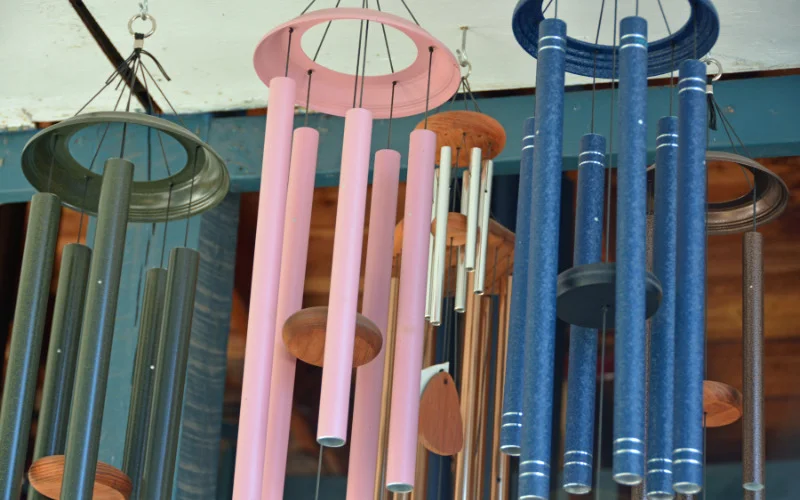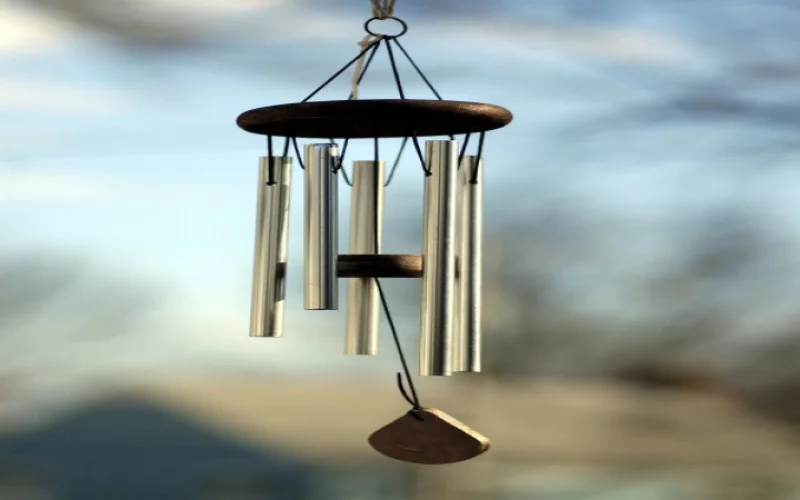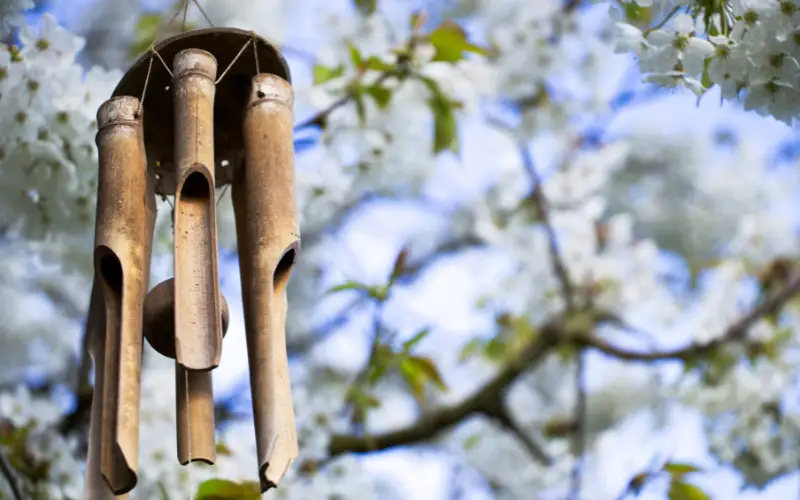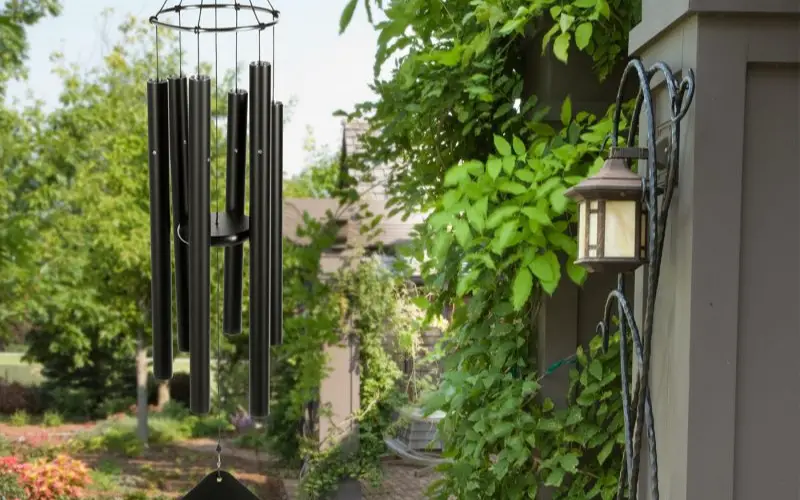You know that dreamy feeling you get when having a lazy weekend in your garden or patio after a long grueling work week, with a glass of juice in one hand and a good novel or magazine in another.
You blend into the scenery, engrossed in your world and generally feeling at peace with yourself and one with nature.
What completes the picture is the magical sound that a wind chime adds to make the scenery “picture perfect.”
As you are there chilling and having a good time and suddenly, a string from your chime comes unstrung. Well, don’t let that bother you because, in this post, you can follow simple steps to restring your wind chime yourself and have them looking great again.
What Are Wind Chimes?

Wind chimes are much more than instruments that give out musical tones as the wind strums them. They are an art that brings sobriety and tranquility to you and your environment in such a calm yet playful way. They give a touch to your whimsical outdoor space.
Wind chimes are percussion instruments that are made up of small pieces of materials or tubes like glasses, metal, bamboo, ceramics, and the likes that are strung together and suspended from a frame hung in the air, and when it is draught, produce a tingling sound that is so appealing. Someone once said that “wind chimes are musical instruments played by the wind.” We agree.
What Are the Benefits of a Wind Chime?
Like most beautiful objects, like gemstones and artwork, their value is very eclectic, and it’s little wonder people keep them for various purposes.
Many people believe that they have some psychic or spiritual powers, but as we will always say,” we stick to what we can prove.”
Many people keep a wind chime around them because of the beautiful and serene tone it produces that can be soothing. It brings a kind of harmony to the different sounds of nature as you relax on your patio.
As a work of art, wind chimes also add some panache to an environment because they can be so beautiful and serve as decoration, both indoors and outdoors.
Many people will buy wind chimes not just for the tone they give out but also for aesthetic reasons, the same way they will buy a chandelier.
Some people will buy a wind chime just for the mesmerizing movement they make. That visible movement for some is alluring and worth buying a unit for.
For some other people, it is a thing of pride and prestige that they owe a chime, and for these people, they are ready to part with a good amount of cash to owe a chime that is out of this world. For some others, it’s a fashion statement that says they are flowing with the trend.
Materials Used in Making Wind Chimes
Different materials are used in making wind chimes, and they all have their pros and cons, unique feel, and sound that they make.
1. Wood and Bamboo
wood chimes made of wood or bamboo give a naturally serene effect on your garden or patio because the material fits into the scenery. They are usually polished wood that is beautiful and unique.
They produce a hollow kind of sound that is clunky; they sound a little like an echo. Some also produce a quiet fountain-like clanking.
Wood and bamboo chimes can expand and shrink slightly under extreme weather, especially if they are hung outside, making them less durable and desirable.
2. Metal
This is a very popular material for making wind chimes because they are more durable than many other materials and withstand the elements. They make a clear and sometimes very sharp tone.
The tubular metal chimes can also be tuned to musical notes, and their tones can be very high or low, depending on the wind’s intensity.
The type of metal used is very important since it is kept outdoors and can become corroded; hence a galvanized metal is the best bet for making metal chimes.
Aluminum is the most popular of metals used because it gives clarity and volume to the chime, and they are also very durable and can stand harsh weather conditions.
3. Ceramics and glass
as these chimes are hung in the air, they look magnificent, especially if they are made of beautiful colors. They look as if they are gemstones hung in the area because they look alluring.
Ceramic and glass wind chimes produce light sounds tinkling with some delicateness even though their tones are not as loud as those of metals. You have to be careful when handling these chimes because they can break when they fall.
4. Shell
there are different types of shells that can be used in making wind chimes. They produce a soft and tinkling sound that feels like rippling water, which gives a soothing effect when you are out there enjoying the beauty of your surroundings.
Selecting Your Wind Chime
Since wind chimes are not just meant for musical benefits alone, but also as a work of art. In choosing one for yourself, you should consider many factors that come to play. Which include your personality, style, and preferences?
Many wind chimes come in different designs, sizes, materials to pick from. The factors that people consider in buying wind chimes include:
- The tone: this is the main reason why propel fix wind chimes in their spaces. The material used in making them determines to a large extent the sound that it gives out. These materials like metal, glass, bamboo, and the others all have a characteristic sound that makes them very distinctive.
- The type of wind chime: there are different types of wind chimes, and they include:
- Tubular chimes: These wind chimes are shaped like rods or tubes, usually made of bamboo or Aluminum. These tubular chimes come in different lengths, and all produce unique tones.
- Bell chimes: Just as their names suggest, they usually comprise more bells than one and are placed vertically on the tubes. There are different shapes, sizes, and materials of bells that give out different tones.
- Decorative chimes: In this type of wind chime, you can put a personal touch on the final product that you hang on your patio. You put different engraving or even use different materials that suit your personality.
- Chimes for occasions and memorials: You can buy wind chimes customized for special occasions that celebrate wedding anniversaries, birthdays, graduation, etc.
- The clarity of the tone: How loud and clear a tone from a wind chime sound is dependent on the size and material used in making it. If you are looking for a sharp and loud sound, you might want to get a metal wind chime; if you want something melancholy, you will opt for wood or bamboo. Hollow chimes produce very loud sounds too.
- Windchime vibration: The vibration time for a chime will determine how long the tone produced will last. The longer the vibration, the longer the tone of the wind chime.
- Durability: Remember that your outdoor wind chime will be subject to the elements, and so if you want one that lasts, then you must choose the material to make wisely. Some metals are galvanized to protect them from rust, and some wood materials are treated to be rot-free. So, choose your wind chime wisely, except you want to replace your wind chime sooner.
- Cost: This is one of the main determinants of what you will buy. A beautiful wind chime that is beyond your budget is a NO for you. So, the money in your pocket will choose your wind chime for you.
Why Restringing Your Wind Chime?

Age and the weather can affect the string of your wind chime, especially if it is fixed outdoors. Adverse weather can cause the strong to get tangled because of the wind, the cold can freeze these strings and make them break or snap, and the effect is that you will have to fix the damage, and at worst, it might fall hurt someone.
So, restringing your wind chime is to restore it and give it a new lease of life, renew the sounds of the chime, and extend the time for repairs or replacing them.
Steps By Steps Guide to Restringing Your Wind Chime
If you have a broken or tangled wind chime and you need to restring it, then you can follow these steps:
- Get the right string: there are different types of strings with different prices and durability. Choose one that suits you.
- Dismantle the unit from where it is hung. Be very careful as some of the strings might snap and shatter, and then you may have broken parts and may be unable to rearrange the unit.
- Remove all the old strings. Place the wind chime on a flat surface and gently pull the string out, and if there are knots, use scissors to cut it. It might be a good idea to not only restringing the old or broken strings but simply restringing all the strings so that you refurbish the whole unit, so you don’t have to restring another broken string sooner.
- Arrange the chime parts accordingly on the flat surface so that you don’t have a problem fixing it back.
- Measure out the string size that you will be using. Remember to leave a little allowance for tying the knots. Put this string through a needle and then attach all the wind chime parts into the string through the already drilled hole. Ensure that the length of all the different strings is equal so that your wind chime doesn’t end up looking like something strung by a child.
- Now you are ready to restring your wind chime. You start from either the top or base and then ensure that you secure it properly.
- You can now knot everything. A common concern with working with strings is that they are thin, and you might not be able to grasp them easily. If that is the case, you can get someone to help, especially if your hands and eyes are not steady.
- After tying the knot, you then trim the string to remove any excess. You can melt the tip of the knots to stop them from loosening afterward.
- Do all your checks to ensure that all the knots are tied properly and that all the strings are symmetrical and balanced. You should also tune the wind chime to ensure that all is set to be hung back.
- Lastly, hang your ‘new’ and improved wind chime in the location that suits you best and enjoy.
How To Restring A Metal Wind Chime
Most wind chimes come in 4 rods or 5 rods type, meaning they are composed of 4 or 5 tubular metals. The heavier these metals are, the more strain they will put on your string, causing it to snap. When restringing a metal wind chime, choose a very durable string that will go with the durability of the metal to last long.
Use the opportunity of restringing your metal chime to clean it and then coat it with good paint or spray to maintain its shine and luster.
How To Restring A Bamboo Wind Chime

Though beautiful to look at, these chimes are not as durable as their metal counterpart, meaning you might have to replace them earlier if you are not carefully handling them.
When you unhang your bamboo wind chime to restring, treat them gently so that they don’t get damaged since they are not as sturdy as metals
You can paint or spray your new string so that it can blend with the bamboo and the environment. Use the opportunity to clean your bamboo with a soft cloth and warm water to keep them looking good.
How To Restring a Concert Chime?
Concert chimes are not the everyday wind chime that you hang in the air, and they are rather a musical instrument kept on the floor with smooth chromatic turning used in concerts and orchestra.
They have dampers that can silence sounds immediately, especially when you don’t want tinkle echoing through silence.
These chimes are large and have up to 34 bars that produce metallic sounds that fit into an orchestra. Because of the cost and technicalities involved in restringing this piece of work, we suggest that you get a professional to do it for you.
How To Restring Ceramic Wind Chimes?
Ceramic wind chimes easily get entangled because, unlike tubular wind chimes, most parts of the strings are exposed, which means that in high winds, they can tangle easily, and this is the major reason why ceramics wind chimes are the most restrung of all wind chimes.
Choose a strong string and a color that fits your wind chime design. You can also paint this string any color of your choice. You can ger colored strings from shops instead of buying and spraying them yourself.
Who Can Restring Your Wind Chime?
You can restring your wind chime by yourself if you feel up to it, and you are sure you won’t do a shoddy job. However, many chimes refurbishing and repair centers can be found online, and surprisingly, they are all around you.
There are also wind chime repair kits that come in handy that you can get that have the basic tools you need to fix your unit.
Some wind chime professionals will not only restring your wind chime, but they will also do other repairs and refurbish them to look more elegant, bigger, and produce better sound.
Fixing Wind Chimes
Asides from restringing your wind chime, the are other things you can do to keep your wind chime working perfectly and improve its sound. You can spray them if you notice that they don’t have that shimmer and shine that got you like them in the first place.
Some parts like the clappers, top piece, and windcatcher can look faded, and spraying them will give them a new gloss. Cleaning them will keep them free of dust and any other blemishes.
Conclusion
Wind chimes have come to stay and are loved by many. If you want one, you can choose from a variety of them that come in different materials that produce different tones.
Replacing your wind chime is one less thing to worry about because you can restring it yourself or get a professional to do it. Either way, you can enjoy them for a lot longer.
You May Also Like:
- What is The Shear Strength of a Deck Screw
- How Do You Find Gemstones in Your Backyard
- How To Find Amethyst in Your Backyard
- Can I Put an Inflatable Pool on my Deck
Hope this article helped you learn How To String a Wind Chime. You may also want to bookmark our article on Deck Screws Shear Strength.
I will love to hear from you if you have any other suggestions on How To String a Wind Chime, all you have to do is comment below and reach out to people by sharing this post on social media.
If you liked this article, then please follow us on Facebook, Instagram, and Pinterest.
Cheers!
www.backyardcaring.com
How To String a Wind Chime (Step-by-Step Guide to Restringing Wind Chimes)

